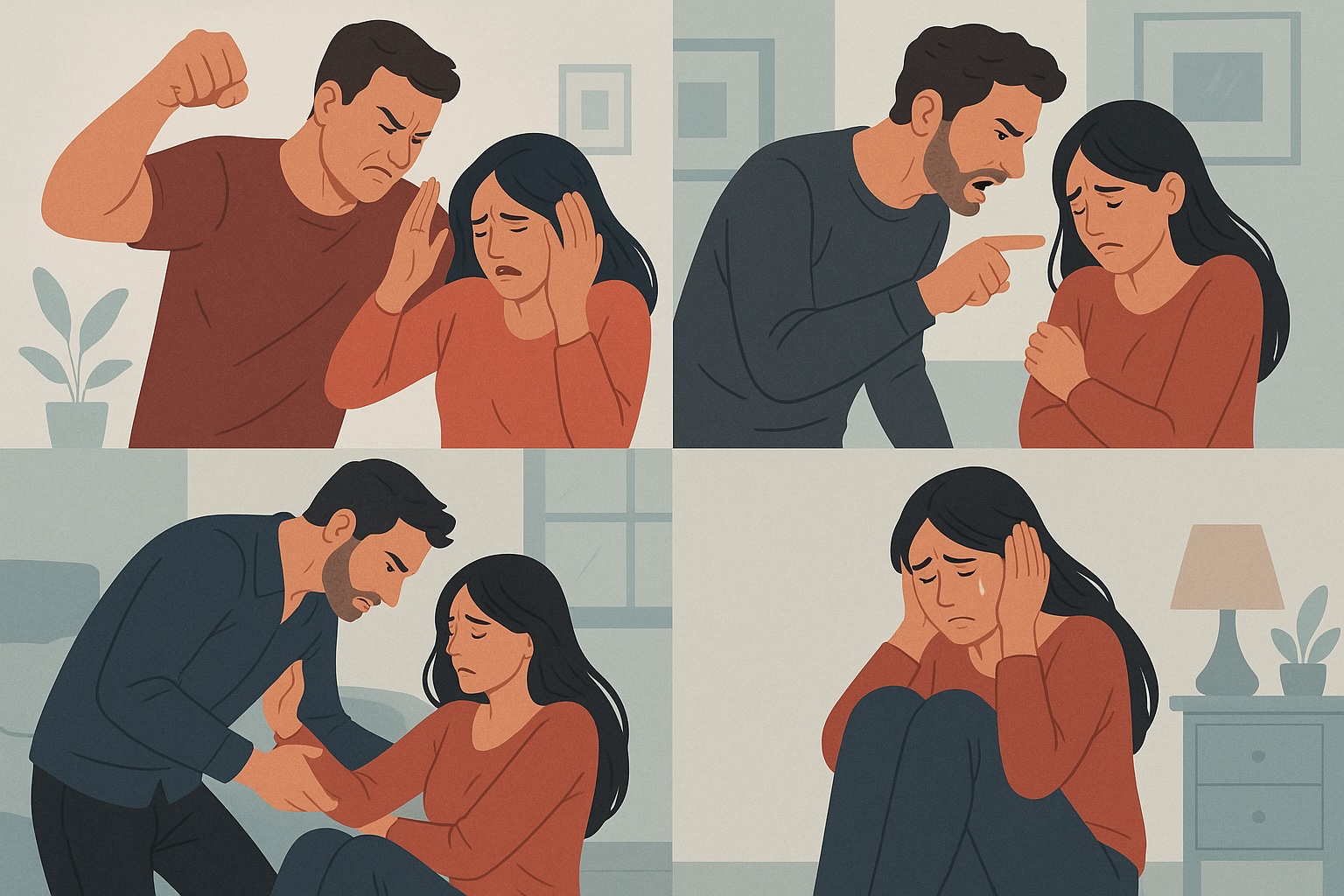What is Domestic Violence? Recognizing the Different Forms of Abuse
Domestic violence is more than physical harm. It includes emotional, financial, sexual, and psychological abuse. Learn the signs and protect yourself or someone you care about.

Domestic violence—also known as intimate partner violence (IPV)—goes beyond bruises and broken bones. It’s a pattern of controlling behavior used to gain power over a partner or family member. Abuse can be emotional, financial, sexual, or psychological—even if no physical force is used.
This post breaks down the most common forms of domestic abuse, so you can recognize them early, support others, or seek help.
🛑 1. Physical Abuse
This is the most visible form of domestic violence, but not the only one. It includes:
Hitting, slapping, punching, or kicking
Pushing, shaking, or restraining
Choking or strangling (a major homicide risk)
Using weapons or threatening to
Blocking exits to prevent escape
Forcing medication or denying access to healthcare
If you’ve experienced strangulation, seek immediate medical care—it can cause delayed injuries.
🧠 2. Emotional and Psychological Abuse
Emotional abuse aims to break your spirit and create constant fear or confusion. Signs include:
Insults, put-downs, and constant criticism
Gaslighting—making you doubt your memory or reality
Isolation from friends, family, or work
Intimidation with looks, gestures, or silence
Threats of suicide or harming pets
Blaming you for their behavior
This form of abuse often precedes physical violence.
💰 3. Financial Abuse
Also called economic abuse, this form limits your ability to be independent. It can involve:
Controlling all household money or refusing to give you any
Forcing you to beg for basic needs
Taking your paycheck or government benefits
Ruining your credit or identity by opening debt in your name
Blocking you from working or going to school
Financial abuse is extremely common—even in relationships without physical violence.
❌ 4. Sexual Abuse
Sexual abuse can happen even in long-term relationships or marriages. It includes:
Forcing sex or sexual acts without consent
Coercing you into unwanted sexual activity (with threats or guilt)
Reproductive control—tampering with birth control or forcing pregnancy
Criticizing or shaming your body or sexuality
Using sex as a weapon or form of punishment
Consent must be ongoing—not assumed because of past intimacy or relationship status.
⚠️ 5. Coercive Control (Now Recognized in Canadian Law)
Coercive control is a long-term pattern of domination and manipulation. It may include:
Surveillance (checking your phone, emails, location)
Controlling your clothing, food, sleep, or routine
Threats to report you to immigration, CAS, or police
Forcing you to isolate from support systems
Making you feel like you’re always walking on eggshells
In Ontario, coercive control is increasingly being used in family court and protection orders—even if physical violence is not reported.
🧠 Understanding the Impact
All forms of domestic violence can cause:
Anxiety, depression, PTSD, and chronic health issues
Trouble concentrating or sleeping
Shame, self-blame, or fear of speaking out
Difficulty trusting others or rebuilding life after abuse
📌 Summary: Forms of Domestic Violence
✅ Physical – hitting, choking, restraining
✅ Emotional – insults, gaslighting, isolation
✅ Financial – control over money, employment sabotage
✅ Sexual – forced acts, reproductive coercion
✅ Coercive control – psychological dominance, threats, surveillance
📞 Where to Get Help
Assaulted Women’s Helpline (24/7): 1-866-863-0511
211 Ontario: Dial 2-1-1 for local supports
Luke’s Place: lukesplace.ca – Legal support for DV survivors
Barbra Schlifer Clinic: Trauma-informed legal and counselling help
Ontario Women’s Shelters: Free and confidential support and housing
Frequently Asked Questions (FAQs)
1. What is the legal definition of domestic violence in Ontario?
In Ontario, domestic violence is not a single criminal charge. Instead, it is understood as a pattern of abusive behaviours (physical, emotional, financial, sexual) committed by someone against a current or former intimate partner. The specific actions, like assault or uttering threats, are what lead to criminal charges.
2. My partner has never hit me, but controls everything I do. Is this abuse?
Yes. This is a clear example of coercive control and financial abuse, which are serious forms of domestic violence. Abuse is about power and control, and it does not have to be physical to be harmful and illegal.
3. What is "gaslighting"?
Gaslighting is a form of psychological abuse where an abuser manipulates you into questioning your own sanity, memory, or perception of reality. They may deny that abusive events happened or twist the facts to make you think you are the one at fault.
4. Is it still considered sexual abuse if we are married?
Yes, absolutely. Being married or in a relationship does not give anyone the right to force sexual activity. Any sexual act without your ongoing, enthusiastic consent is considered sexual assault under Canadian law.
5. Can I get a restraining order for non-physical abuse?
Yes. You can get a restraining order based on a pattern of emotional abuse, coercive control, or credible threats of harm. A judge will consider all forms of abuse when deciding if you have a reasonable fear for your safety.
6. Where can I get help if I am experiencing any of these forms of abuse?
For immediate, confidential support and safety planning, you can call the Assaulted Women's Helpline in Ontario 24/7 at 1-866-863-0511. They can help you understand your situation and connect you with local resources like shelters and counselling. If you are in immediate danger, always call 911.
